RAID 01 vs RAID 10: Is There Any Difference?
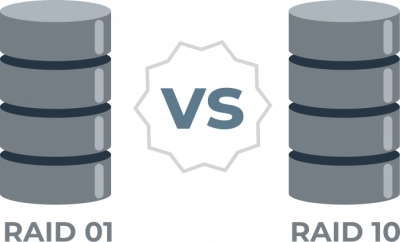
There are many storage technologies and devices that exist today. RAIDs (Redundant Array of Independent Drives) are considered safer than regular hard drives. However, there are various kinds of RAIDs, starting from RAID0 to RAID10.
Article content:
- What is RAID 10 and RAID 01?
- Configuration of RAID 10 & RAID 01
- RAID 10 vs. RAID 01 comparison
- How to recover data from RAID drive
RAID 10 vs RAID 01
What is RAID 10 and RAID 01?
The various types of RAIDs have unique characteristics, as well as have their advantages and disadvantages. Here, we’d be focusing on RAID 01 and RAID 10 - these RAID array types confuse a lot of people, but in this article, we’d clear the confusion.
What is RAID 01?
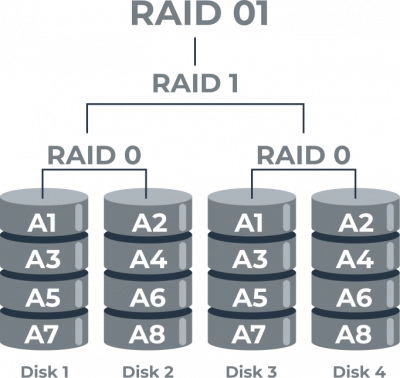
RAID 01 refers to a somewhat complex RAID array where the arrays are set up as RAID 1 but the elements are RAID 0. This setup gives you the benefit of RAID 0 (faster speed) and the benefit of RAID 1 (more safety). Technically, it is easier to set up RAID 01 than RAID 3, 5, and 6.
As a nested RAID level, RAID 01 offers data sharing and replication; it supports mirroring data across the arrays.
To further explain this RAID array, it is important to note that RAID 01 stripes multiple disks into sets and still mirrors them together. But, the issue here is that when one drive in the array stops working, everything ceases, and you won’t be able to access your files.
Tip: RAID 0 failed!What is RAID 10?
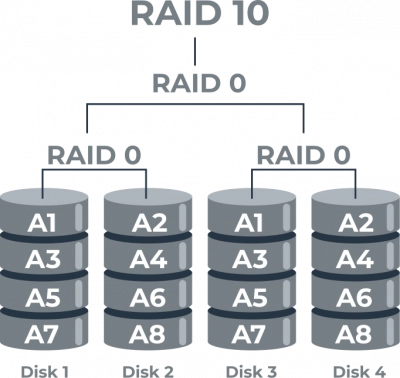
You can easily guess that RAID 10 is the inverse of RAID 01, well, that’s close to a perfect answer, but not the answer. RAID 10 is a blend of RAID 1 and RAID 0, which is more like a blend of disk mirroring and disk striping, literally. With this RAID, you can actually achieve faster speed and more security.
Just like in RAID 01, RAID 10 merges the benefits and characteristics of RAID 0 and RAID 1. Thence, RAID 10 is considered the first hybrid RAID combination. To set up this RAID array, you need at least four (4) disks; data would be stripped across mirrored pairs.
One of the biggest advantages of this RAID setup is that you can recover data from the RAID even when one of the disks goes bad. Yes, recovery is possible because of the mirroring support; so, you’d recover the lost file from one of the mirrored pairs. But then, if two disks fail across a similar mirrored pair, you may lose your important files in the array. Generally, RAID 10 a better security than other types of similar arrays.
Note: how many disks for RAID 10Ready to get your data back?
To start recovering your data, documents, databases, images, videos, and other files from your RAID 10, RAID 1, press the FREE DOWNLOAD button to get the latest version of DiskInternals RAID Recovery® and begin the step-by-step recovery process. You can preview all recovered files absolutely for free. To check the current prices, please press the Get Prices button. If you need any assistance, please feel free to contact Technical Support. The team is here to help you get your data back!
Configuration of RAID 10 & RAID 01
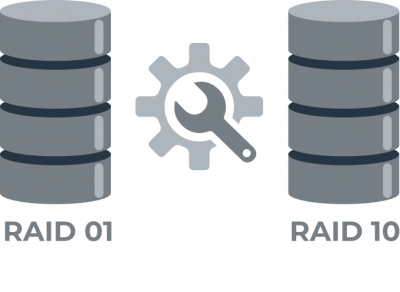
Of course, the configurations of these RAIDs are different and pretty complex. Understanding the configurations of these RAIDs would help you choose which one is best for your need, and then set it up.
First off, RAID 10 (RAID 1+0), also known as Stripe of Mirrors is a RAID configuration that requires a minimum of four (4) disks; the disks are set up as pairs; so, when data is stored on one of the disks in the pair, the mirrored copy of the saved data would be saved on the other disk in the pair.
This means that your data is saved on two different disks, literally. If you're using 8 disks for RAID, you'd have 4 pairs of disks to deal with. Now, that's for RAID 10, what about RAID 01.
RAID 01 (RAID 0+1), also referred to as "Mirror of Stripes" can be set up using 3 disks.
But, it is advisable to use at least 4 disks. In this RAID setup, data is striped across the grouped disks, every data block is linked with a different disk. So, data is mirrored across disks with the same blocks.
RAID 10 vs. RAID 01 comparison
There are a few similarities between these two types of arrays, and of course, there are differences too. With the explanations above, you could be able to tell the similarities and differences between these two RAID configurations, notwithstanding, here’s is a detailed comparison of RAID 10 and RAID 01.
Similarities
Starting with the similarities, RAID 10 and RAID 01 offer almost the same performance in terms of reading and write speeds. They also provide a lot of space for you to save your files. These three points (performance, speed, and space) are the core similarities between RAID 10 and 01.
Differences
Here are the main things that matter - setting up RAID 10 is much simpler than RAID 01. Sounds interesting? RAID 10 also offers more reliability - data protection and security - than RAID 01. The fault tolerance of RAID 01 is lower, and that’s why RAID 10 offers more security.
When you set up RAID 10, you can access your files even after one of the disks in the array fails. Basically, there is no advantage of RAID 01 over RAID 10. So, it is better to set up RAID 10 than RAID 01.
Note: RAID rebuild time.Recover your Lost Data Using DiskInternals RAID Recovery
DiskInternals RAID Recovery is a professional software that lets you recover lost files and data from all types of RAID arrays. This program is trusted by IT experts and has been regularly improved for more than 15 years. The DiskInternals RAID Recovery is packed with a suite of useful features, and it supports various file systems.
With this utility program, you can recover data from different RAIDs, both software and hardware RAIDs for Linux, macOS, and Windows OS. There are three (3) recovery modes supported by this program; plus, it features a built-in Recovery Wizard to help you through the data recovery process.
DiskInternals RAID Recovery is a reliable software solution for recovering data on Windows PCs. Furthermore, you can recover any file type with this program. Below are the steps on how to use this data recovery solution.
First Step:
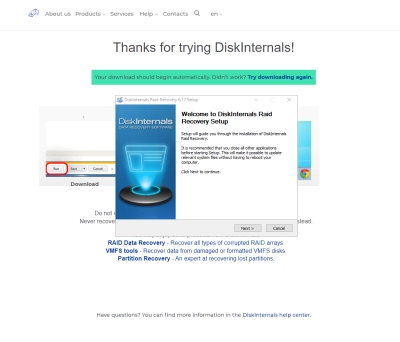
Firstly, you need to turn off your computer/network server and disconnect the RAID drives in the array.
Second Step:
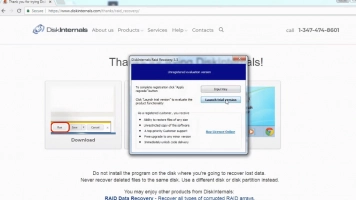
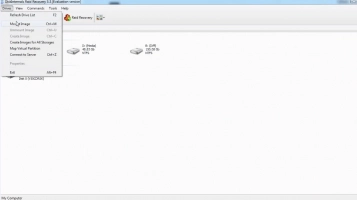
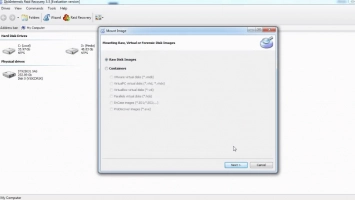
Remove the drives and connect them to a computer system via USB or any other supported means of connectivity.
Third Step:
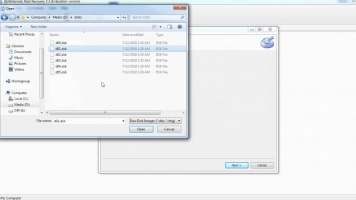
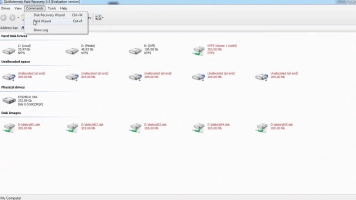
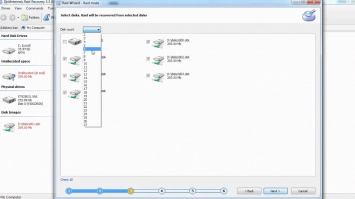
Boot the computer where the hard drives are connected and install DiskInternals RAID Recovery software. After the installation, launch the program and follow the Recovery Wizard prompts to recover your lost files from each of the connected drives, one after another.
Tip: RAID 0 failed!Why Use DiskInternals RAID Recovery?
It is a pretty much-advanced software solution - preferred by experts and works very fast. There are three recovery modes, so you have to choose the one best for you at the moment.
- Recovers data from both software and hardware RAIDs.
- Supports manual and automated recovery (Recovery Wizard) options.
- Recovered files and folders can be saved to remote directories or local drive.
- Supports Unicode filenames and multi-level folders.
- Can be used to create disk images (data backups).
- Recovers data from unmountable, badly damaged pools.
- Automatically fixes pool and filesystem parameters, including disk order.
- Recovers previous versions of files if available.
- Verifies checksums to validate data credibility.
When you use DiskInternals RAID Recovery, you can also back up your important files in the form of Disk Images to keep them from getting lost in the case of any data loss scenario. Hereunder are some useful tips on what you need to know about data recovery.
Recovery Tips:
- When recovering lost files and data from any drive, don’t rush the process - allow each step to run completely and successfully before proceeding to the next.
- Ensure that you selected the right drive when prompted to choose the drive you want to recover files from. Choosing the wrong drive won’t get back any of your lost files.
- Thanks to DiskInternals RAID Recovery previewing engine, you can preview all the recovered files before saving them back to your local or remote storage.
Finally, make sure you don’t save the recovered files on the same drive where they were previously saved - and got lost.
Tip: RAID 0 or RAID 1: what to pick?Conclusion:
Summarily, RAID 10 is pretty much better than RAID 01; however, the two RAID configurations would give you the same speed levels and a large amount of space to save your files. Notwithstanding, anything could happen and you'd lose your files from the disks in either of these arrays. To stay safe, use DiskInternals RAID Recovery to back up your files, or recover the ones you've lost already. software. Interestingly, this software works for file backups, and it is reliable - highly efficient - for data recovery.
RAID 10 vs RAID 01 is the commonest RAID comparison you’d find on the internet. This because both RAID configurations are pretty much similar. RAID 10 and RAID 01 have their differences, and that’s what is discussed below. Well, you can lose your files from either of these RAIDs; thence, this article introduces DiskInternals RAID Recovery, a professional tool that helps you for data backup and recovery.
